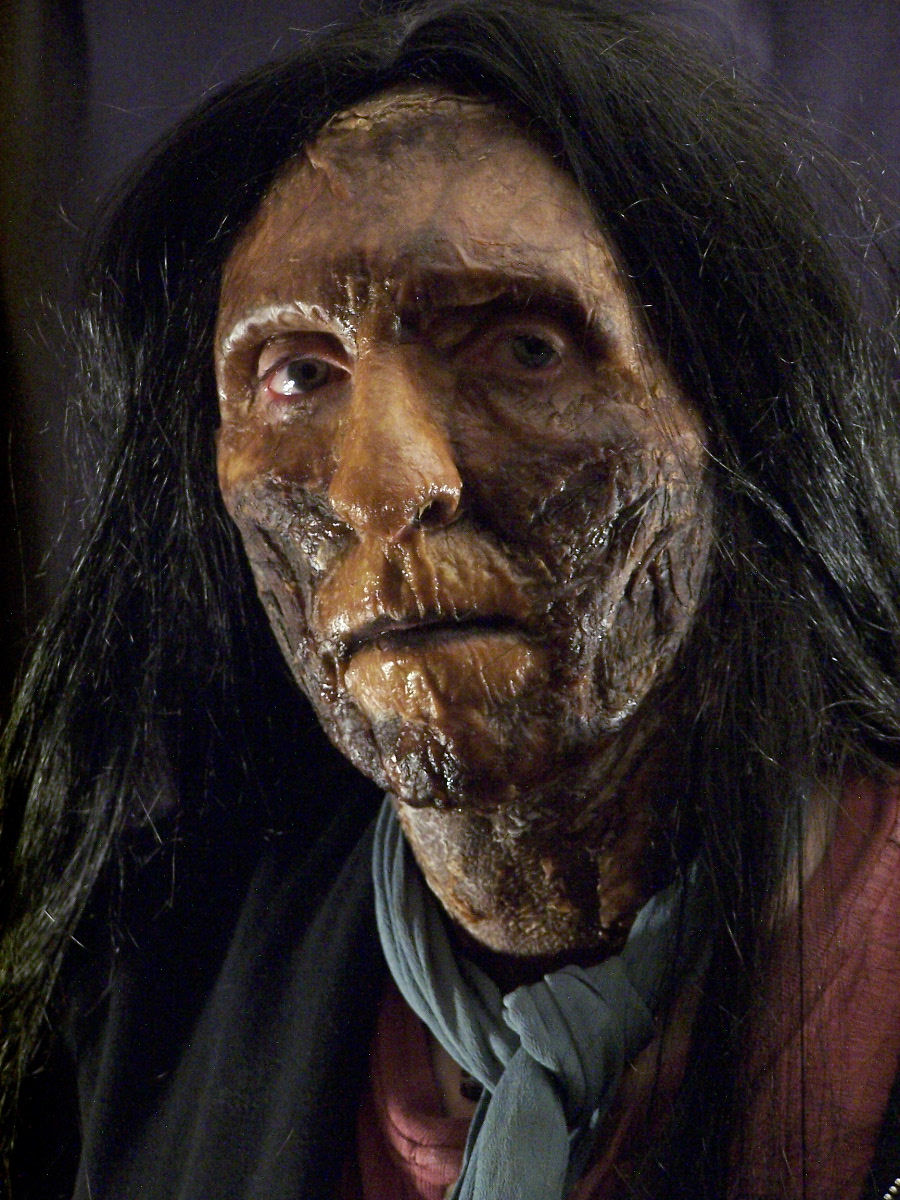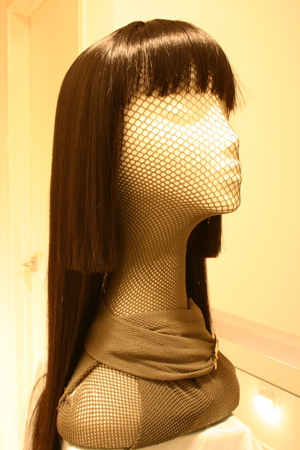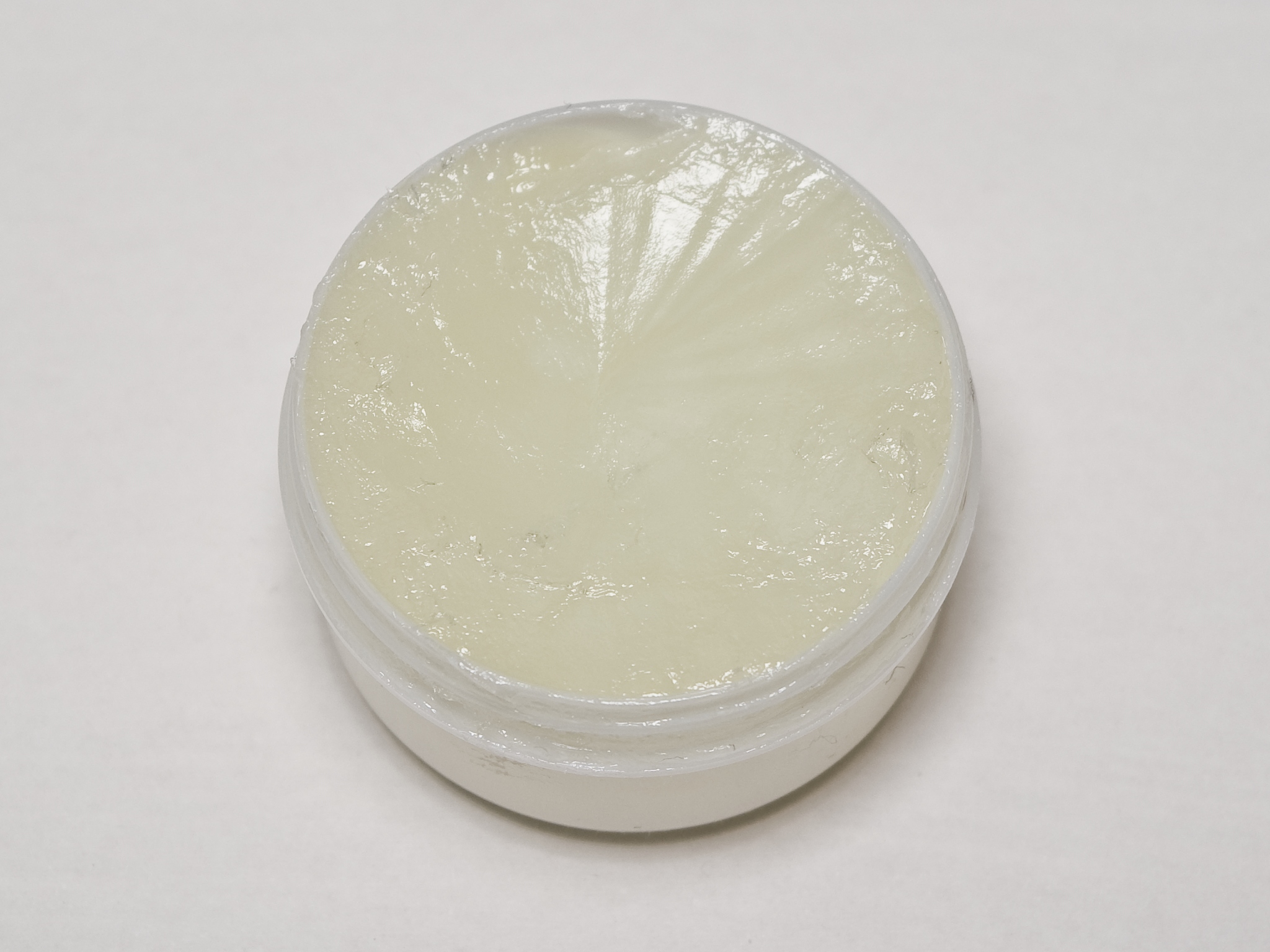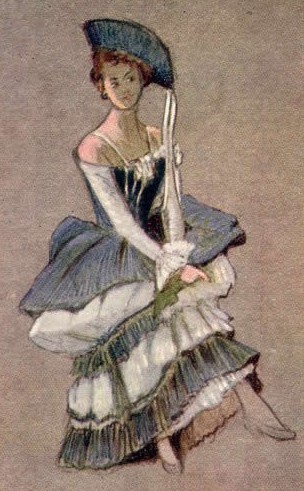|
Spirit Gum
Spirit gum is an adhesive, made mostly of SD Alcohol 35-A (the solvent, or "spirit") and resin (the adhesive, or "gum") originally consisting of mastix, used primarily for affixing costume prosthetics such as wigs, merkins, or false facial hair. It has been manufactured since at least the 1870s, and has long been a standard tool in theatrical performances where prosthetic makeup or affixed costuming is used. It was mentioned in the earliest known published theatre makeup manual: "How to make-up; a practical guide for amateurs by Haresfoot and Rouge" in 1877. At the end of the nineteenth century, spirit gum could be procured by performers at theatrical wig makers and it was removed with alcohol, cocoa butter or petroleum jelly Petroleum jelly, petrolatum, white petrolatum, soft paraffin, or multi-hydrocarbon, CAS number 8009-03-8, is a semi-solid mixture of hydrocarbons (with carbon numbers mainly higher than 25), originally promoted as a topical ointment for its .... [...More Info...] [...Related Items...] OR: [Wikipedia] [Google] [Baidu] |
Adhesive
Adhesive, also known as glue, cement, mucilage, or paste, is any non-metallic substance applied to one or both surfaces of two separate items that binds them together and resists their separation. The use of adhesives offers certain advantages over other binding techniques such as sewing, mechanical fastenings, or welding. These include the ability to bind different materials together, the more efficient distribution of stress across a joint, the cost-effectiveness of an easily mechanized process, and greater flexibility in design. Disadvantages of adhesive use include decreased stability at high temperatures, relative weakness in bonding large objects with a small bonding surface area, and greater difficulty in separating objects during testing. Adhesives are typically organized by the method of adhesion followed by ''reactive'' or ''non-reactive'', a term which refers to whether the adhesive chemically reacts in order to harden. Alternatively, they can be organized eith ... [...More Info...] [...Related Items...] OR: [Wikipedia] [Google] [Baidu] |
SD Alcohol 35-A
SD Alcohol 35-A is a specially denatured alcohol containing 95.38% ethanol and 4.62% ethyl acetate. Uses of SD Alcohol 35-A include its use as the solvent in spirit gum Spirit gum is an adhesive, made mostly of SD Alcohol 35-A (the solvent, or "spirit") and resin (the adhesive, or "gum") originally consisting of mastix, used primarily for affixing costume prosthetics such as wigs, merkins, or false facial hair .... References {{DEFAULTSORT:Sd Alcohol 35-A Alcohols ... [...More Info...] [...Related Items...] OR: [Wikipedia] [Google] [Baidu] |
Resin
In polymer chemistry and materials science, resin is a solid or highly viscous substance of plant or synthetic origin that is typically convertible into polymers. Resins are usually mixtures of organic compounds. This article focuses on naturally occurring resins. Plants secrete resins for their protective benefits in response to injury. The resin protects the plant from insects and pathogens. Resins confound a wide range of herbivores, insects, and pathogens, while the volatile phenolic compounds may attract benefactors such as parasitoids or predators of the herbivores that attack the plant. Composition Most plant resins are composed of terpenes. Specific components are alpha-pinene, beta-pinene, delta-3 carene, and sabinene, the monocyclic terpenes limonene and terpinolene, and smaller amounts of the tricyclic sesquiterpenes, longifolene, caryophyllene, and delta-cadinene. Some resins also contain a high proportion of resin acids. Rosins on the other hand are ... [...More Info...] [...Related Items...] OR: [Wikipedia] [Google] [Baidu] |
Mastix
''Pistacia lentiscus'' (also lentisk or mastic) is a dioecious evergreen shrub or small tree of the genus ''Pistacia'' native to the Mediterranean Basin. It grows up to tall and is cultivated for its aromatic resin, mainly on the Greek island of Chios and around the Turkish town of Çeşme.''Pistacia lentiscus'' L. a Mansfeld's Database Taxonomy Description 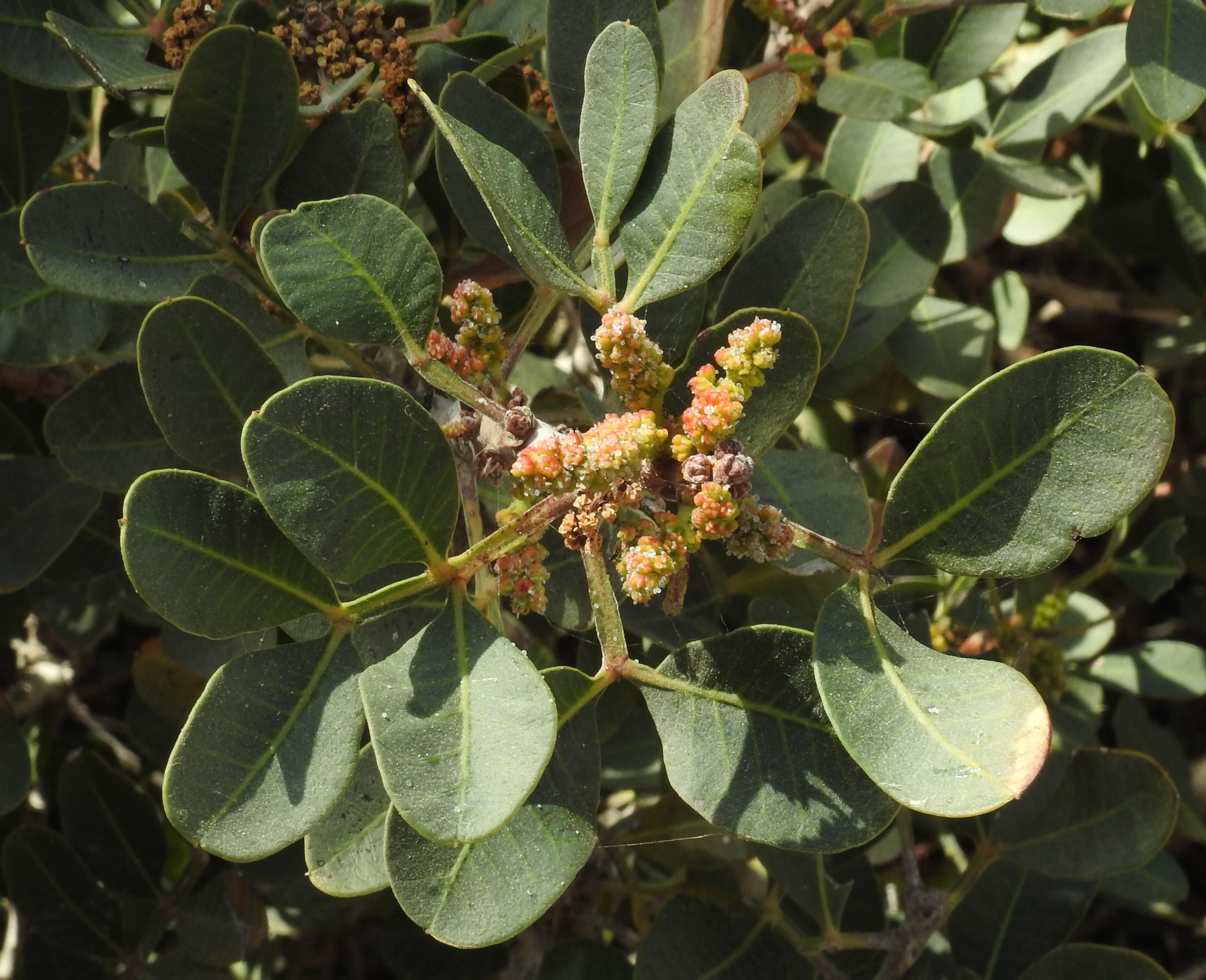 The pla ...
The pla ...
[...More Info...] [...Related Items...] OR: [Wikipedia] [Google] [Baidu] |
Prosthetic Makeup
Prosthetic makeup also called special make-up effects and FX prosthesis) is the process of using prosthetic sculpting, molding and casting techniques to create advanced cosmetic effects. Prosthetic makeup goes back to the beginning of film making with ''A Trip to the Moon'' Fench film ''Le Voyage dans la Lune'' a 1902 French adventure short film directed by Georges Méliès where the man on the moon effect was accomplished using a combination of makeup and a prosthetic type mask with added pastes. The makeup artist Jack Pierce was another early Hollywood make-up artist, best remembered for creating the iconic makeup worn by Boris Karloff in ''Frankenstein'', his makeup for '' the Wolfman'', and more. Modern prosthetic makeup was revolutionized by John Chambers, whose work can be seen in ''Planet of the Apes'' as well as Dick Smith's work in ''Little Big Man,'' Stan Winston in the ''Terminator'' series, and Rob Bottin in '' The Thing''. Many of the techniques developed dur ... [...More Info...] [...Related Items...] OR: [Wikipedia] [Google] [Baidu] |
Wigs
A wig is a head or hair accessory made from human hair, animal hair, or synthetic fiber. The word wig is short for periwig, which makes its earliest known appearance in the English language in William Shakespeare's ''The Two Gentlemen of Verona''. Some people wear wigs to disguise baldness; a wig may be used as a less intrusive and less expensive alternative to medical therapies for restoring hair or for a religious reason. History Ancient and medieval use In Egyptian society men and women commonly had clean shaven or close cropped hair and often wore wigs. The ancient Egyptians created the wig to shield shaved, hairless heads from the sun. They also wore the wigs on top of their hair using beeswax and resin to keep the wigs in place. Wealthy Egyptians would wear elaborate wigs and scented head cones of animal fat on top of their wigs. Other ancient cultures, including the Assyrians, Phoenicians, Jews in ancient Israel, Greeks and Romans, also used wigs as an everyday fashion. ... [...More Info...] [...Related Items...] OR: [Wikipedia] [Google] [Baidu] |
Merkin
__NOTOC__ A merkin is a pubic wig. Merkins were worn by sex workers after shaving their mons pubis, and are now used as decorative items, erotic devices, or in films, by both men and women. History and etymology The '' Oxford Companion to the Body'' dates the origin of the pubic wig to the 1450s. According to the publication, women would shave their pubic hair for personal hygiene and to combat pubic lice. They would then don a merkin. Also, sex workers would wear a merkin to cover up signs of disease, such as syphilis. The ''Oxford English Dictionary'' dates the first written use of the term to 1617. The word probably originated from ''malkin'', a derogatory term for a lower-class young woman, or from ''Marykin'', a pet form of the female given name ''Mary''. Contemporary use In Hollywood filmmaking, merkins can be worn by actors and actresses to avoid inadvertent exposure of the genitalia during nude or semi-nude scenes. The presence of the merkin protects the actor from ina ... [...More Info...] [...Related Items...] OR: [Wikipedia] [Google] [Baidu] |
Cocoa Butter
Cocoa butter, also called theobroma oil, is a pale-yellow, edible fat extracted from the cocoa bean. It is used to make chocolate, as well as some ointments, toiletries, and pharmaceuticals. Cocoa butter has a cocoa flavor and aroma. Its melting point is just below human body temperature. Extraction and composition Cocoa butter is obtained from whole cocoa beans. For use in chocolate manufacture, the beans are fermented before being dried. The beans are then roasted and separated from their hulls to produce cocoa nibs. About 54–58% of the cocoa nibs is cocoa butter. The cocoa nibs are ground to form cocoa mass, which is liquid at temperatures above the melting point of cocoa butter and is known as cocoa liquor or chocolate liquor. Chocolate liquor is pressed to separate the cocoa butter from the non-fat cocoa solids. Cocoa butter is sometimes deodorized to remove strong or undesirable tastes. Cocoa butter contains a high proportion of saturated fats as well as monounsa ... [...More Info...] [...Related Items...] OR: [Wikipedia] [Google] [Baidu] |
Petroleum Jelly
Petroleum jelly, petrolatum, white petrolatum, soft paraffin, or multi-hydrocarbon, CAS number 8009-03-8, is a semi-solid mixture of hydrocarbons (with carbon numbers mainly higher than 25), originally promoted as a topical ointment for its healing properties. The Vaseline brand is a well known American brand of petroleum jelly since 1870. After petroleum jelly became a medicine-chest staple, consumers began to use it for cosmetic purposes and for many ailments including toenail fungus, genital rashes (non- STD), nosebleeds, diaper rash, and common colds. Its folkloric medicinal value as a "cure-all" has since been limited by better scientific understanding of appropriate and inappropriate uses. It is recognized by the U.S. Food and Drug Administration (FDA) as an approved over-the-counter (OTC) skin protectant and remains widely used in cosmetic skin care, where it is often loosely referred to as mineral oil. History Marco Polo in 1273 described the oil exportation of ... [...More Info...] [...Related Items...] OR: [Wikipedia] [Google] [Baidu] |
Costume Design
Costume design is the creation of clothing for the overall appearance of a character or performer. Costume may refer to the style of dress particular to a nation, a class, or a period. In many cases, it may contribute to the fullness of the artistic, visual world which is unique to a particular theatrical or cinematic production. The most basic designs are produced to denote status, provide protection or modesty, or provide visual interest to a character. Costumes may be for a theater, cinema, musical performance, cosplay, parties, or other events. Costume design should not be confused with costume coordination which merely involves altering existing clothing, although both create stage clothes. Four types of costumes are used in theatrical design: historical, fantastical, dance, and modern. History Ancient Greek village festivals and processions in honor of Dionysus (See also: Dionysia) are believed to be the origin of theatre, and therefore theatre costume. Sculpture and va ... [...More Info...] [...Related Items...] OR: [Wikipedia] [Google] [Baidu] |

.jpg)
